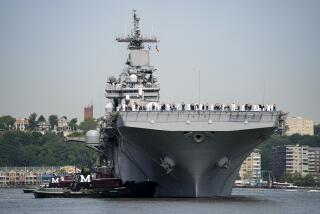CLASH OVER THE MEDITERRANEAN : Training, Tactics Paid Off for American Pilots
- Share via
WASHINGTON — In Wednesday’s high-speed aerial combat, played out at 7,000 feet above the Mediterranean, American naval aviators used textbook fighter-jock maneuvers against less experienced Libyan fliers.
And the outcome, destruction of the two Libyan jets without U.S. losses, points up the importance of intensive pilot training and the highly flexible tactics that American pilots are allowed to use, experts said Thursday.
The downing of the Libyan jets was conducted by “relatively senior, extraordinarily experienced officers,” according to Pentagon spokesman Dan Howard. The pilots and their back-seat radarmen, probably in their mid-30s, used a variety of tactics--attempting first to scare off, then divide and conquer the Libyans.
“This was a classic contrast between American and Soviet-style tactics,” said Benjamin S. Lambeth, a specialist in tactical air power at the Santa Monica-based RAND Corp.
‘Welded Wing’ Approach
“The outcome here was driven by tactics and proficiency,” which pitted an inflexible brand of Soviet-style aerial combat--sometimes derisively called the “welded wing” approach--against a pair of American warplanes flying in loose coordination with one another.
Most of the Libyan pilots’ moves were dictated by military controllers on the ground, Pentagon officials said. By contrast, Howard said, the F-14 Tomcats, guided only by their “rules of engagement,” acted virtually autonomously. About 70 miles away, air warfare coordinators aboard the carrier Kennedy listened in on the radio exchanges among the pilots and their principal outside sources of information, an E-2C Hawkeye airborne radar-warning plane, but the coordinators did not intervene.
Eight minutes and two seconds after the Libyan MIG-23s, dubbed Floggers in North Atlantic Treaty Organization jargon, were spotted taking off, the engagement was over. In the words of one of the American pilots: “Two Floggers splashed. We’re heading north.”
‘Hostile by Origin’
Experts said that the Navy Tomcats were clearly operating under rules of engagement that did not require pilots to have a potential adversary within visual sight before firing. Instead, the planes could have been considered “hostile by origin”--a Libyan military air base--or “hostile by action.”
The dramatic transcript of the American airmen’s conversations during the clash shows that the U.S. pilots believed that the Libyan jets, dubbed “bogies” in cockpit argot, demonstrated their hostility by pointing directly at the American jets, or keeping their “noses on,” as the U.S. pilots tried to maneuver out of the way.
Within the Tomcats’ cockpits, the persistent Libyan countermoves were perceived as an effort to keep the American warplanes within the sights of the Floggers’ firing mechanisms.
While still 12 miles away in the cloudy skies over the Mediterranean, the “lead” F-14, whose pilot calls the plays for his “section” of two aircraft, fired a pair of radar-guided Sparrow missiles at the Libyans, missing them.
“Aw, Jesus,” exclaimed the weapons officer of the lead Tomcat.
But as the four planes bore down on each other to within six miles, the Navy aviators split apart in a much-practiced maneuver called the “drag.” The tactic is designed to force opposing aircraft to commit themselves in one direction or the other.
It worked. The Libyan jets responded as intelligence briefers have long said they would: The lead Libyan fighter and his “wingman,” flying together in what experts call the “welded wing” formation, turned on the American “wingman.”
Benefits of Surprise
While the tight pairing of planes may concentrate an attack, Western tacticians believe that American planes, often flying miles apart but in “mutual support,” can reap the benefits of surprise.
While the Libyan MIGs adjusted course to head straight for the wingman Tomcat, the lead F-14, now a “free fighter,” could engage the Libyan jets from a new angle.
Within 2 miles of each other, the American wingman called “Tally Two, Tally Two,” announcing that he had sighted the two Libyan jets coming toward him. Targeting the lead MIG fighter, this Tomcat fired off a Sparrow missile, which hit its mark seconds later.
“I’ve got the other one,” said the lead Navy pilot, as the Libyan wingman, in what many experts called a fatal mistake, turned tail. The about-face brought the lead Tomcat into an ideal position, and just within range, to use his Sidewinder heat-seeking missiles.
Twice the Sidewinder failed to make the growling tone that indicates that it has found its target. But as the lead pilot swung behind the fleeing craft, it took what pilots call a “hot side shot,” sending the second MIG into the Mediterranean.
“The Libyan track record is not very good in their use of their aircraft,” said Howard, who added that “in the past, they’ve had the prudence . . . to go home when we’ve made some indication that we don’t want them to come out and visit our ships.”
More to Read
Sign up for Essential California
The most important California stories and recommendations in your inbox every morning.
You may occasionally receive promotional content from the Los Angeles Times.














